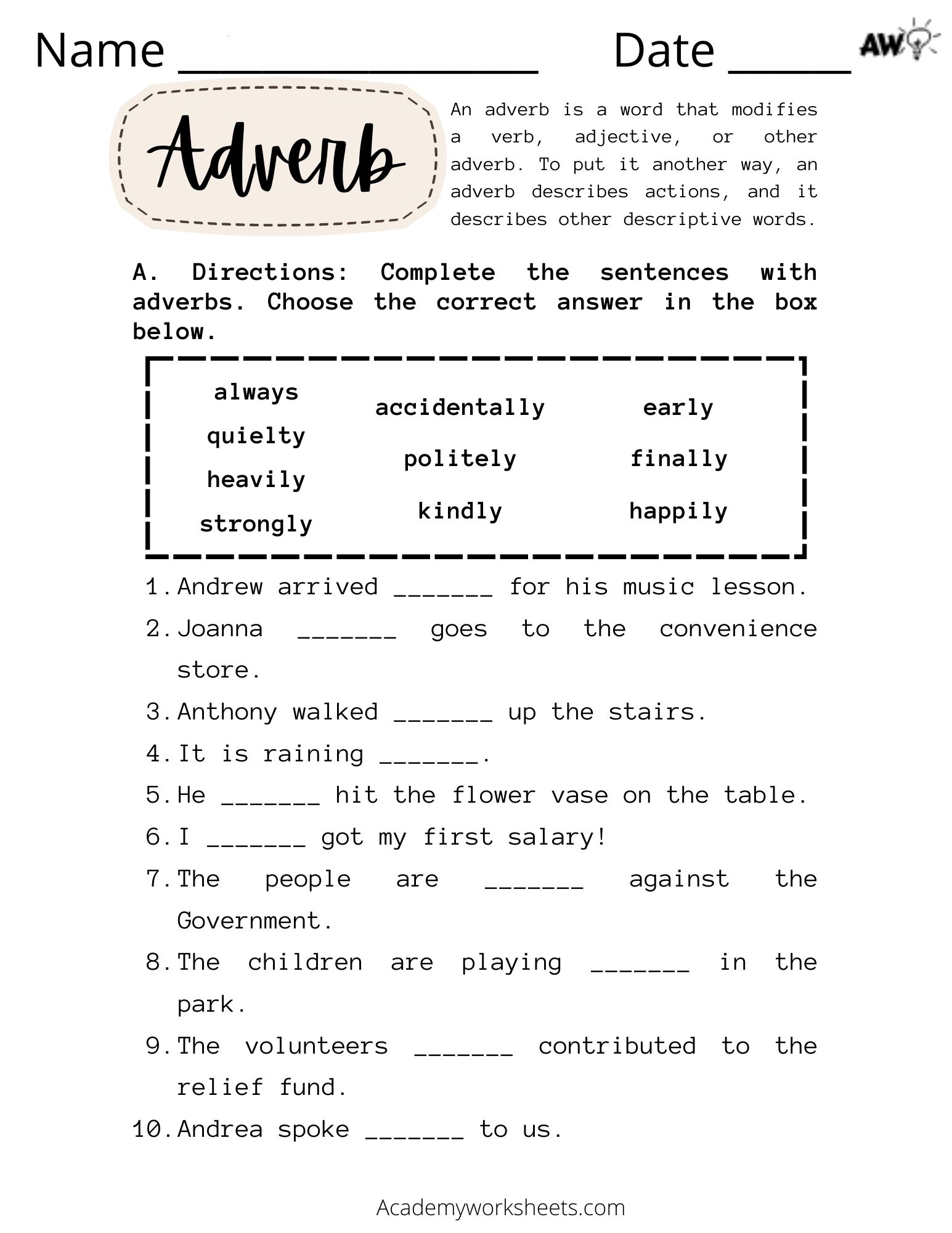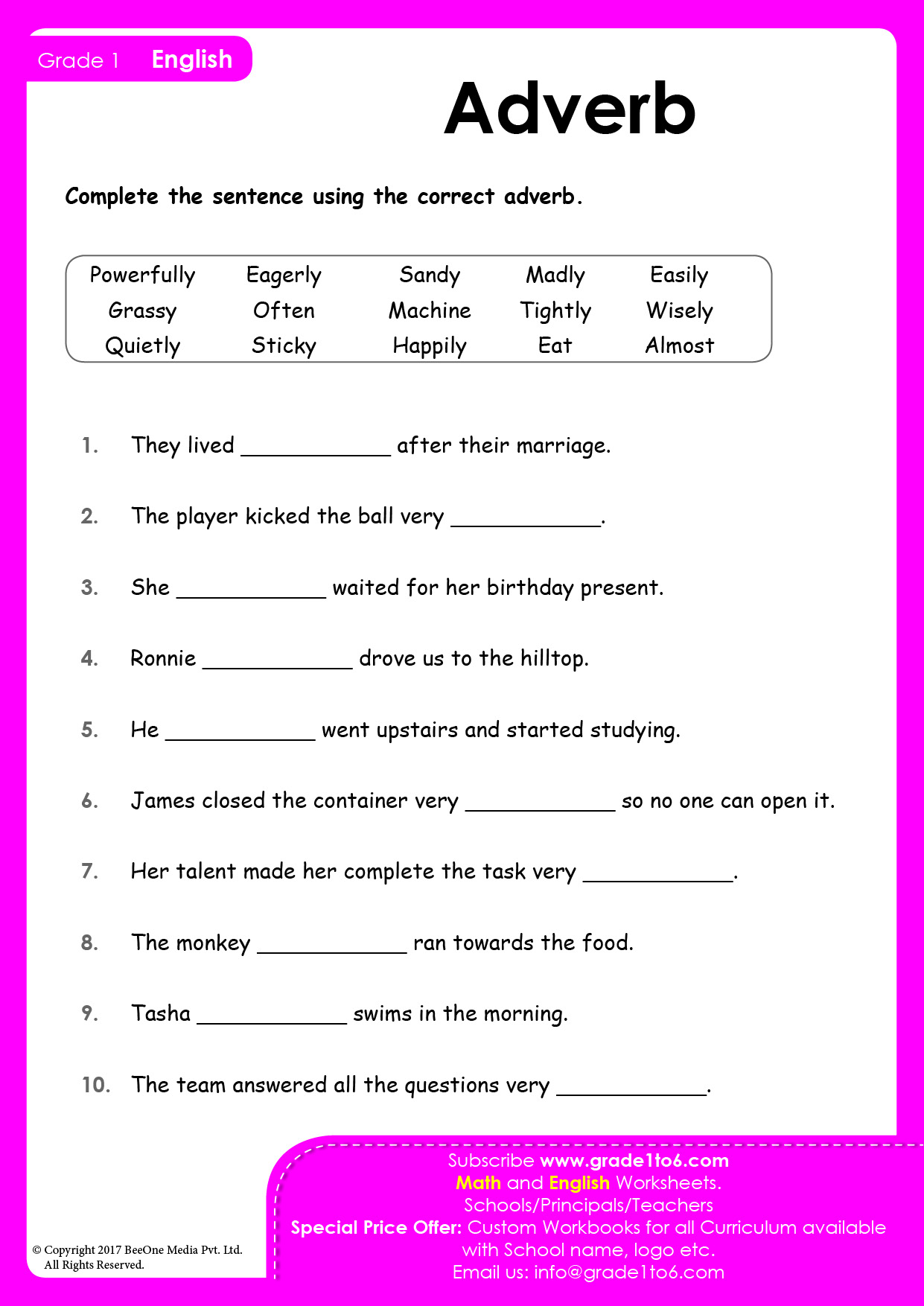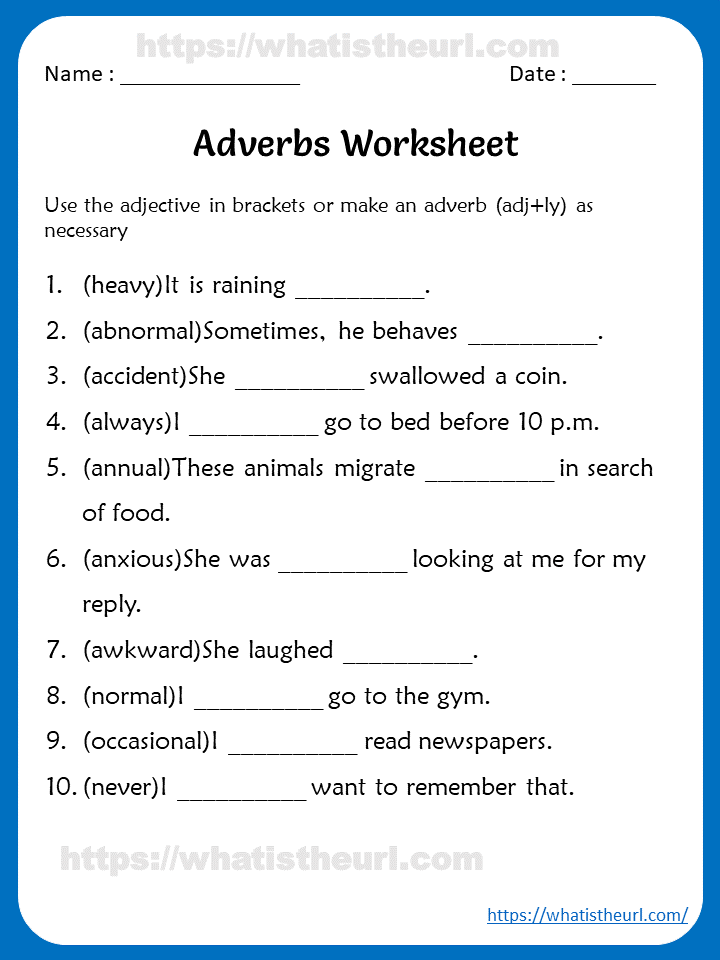
Unlocking Expressive Language: The Indispensable Role of Grammar Worksheets: Adverbs
In the intricate tapestry of the English language, where words weave together to form meaning, clarity, and emotion, grammar serves as the essential framework. While nouns give us things and verbs give us actions, it is often the humble adverb that adds the color, the nuance, and the precision that transforms a basic sentence into a vivid, engaging piece of communication. Adverbs are the unsung heroes that tell us how, when, where, to what extent, and why an action occurs, or even modify adjectives and other adverbs, painting a complete picture for the listener or reader.
However, despite their crucial role, adverbs can be notoriously tricky for English language learners and even native speakers to master. Their flexible placement, diverse forms, and subtle distinctions often lead to confusion. This is precisely where well-designed Grammar Worksheets: Adverbs become an indispensable tool. These structured exercises provide the targeted practice, reinforcement, and analytical opportunities necessary to demystify adverbs and empower learners to wield them effectively, thereby enriching their expressive capabilities.

The Nuance of Adverbs: More Than Just "-ly" Words

Before delving into the power of worksheets, it’s vital to appreciate the multifaceted nature of adverbs. While many adverbs end in "-ly" (e.g., quickly, beautifully, carefully), this is far from a universal rule. Many common adverbs do not follow this pattern (e.g., now, here, often, very, well, fast). Moreover, adverbs can belong to several categories, each adding a different layer of information to a sentence:

- Adverbs of Manner: Describe how something is done. (e.g., He sings beautifully. She walks slowly.)
- Adverbs of Place: Indicate where something happens. (e.g., They live here. The cat ran outside.)
- Adverbs of Time: Specify when something occurs. (e.g., We will meet tomorrow. She arrived late.)
- Adverbs of Frequency: Tell how often something happens. (e.g., He always wakes up early. They rarely visit.)
- Adverbs of Degree: Express to what extent or how much. (e.g., She is very happy. He is quite tired.)
- Conjunctive Adverbs: Connect independent clauses and show relationships between ideas (e.g., however, therefore, moreover).
- Sentence Adverbs: Modify an entire sentence, expressing the speaker’s attitude or opinion (e.g., Fortunately, we made it on time. Clearly, he was mistaken.)




This broad spectrum of forms and functions underscores why rote memorization is insufficient. Learners need contextual practice, consistent exposure, and opportunities to apply their knowledge – precisely what Grammar Worksheets: Adverbs offer.
Why Worksheets Are Essential for Adverb Mastery

In an age of digital learning, the humble worksheet might seem old-fashioned, but its pedagogical value remains unparalleled, especially for complex grammatical concepts like adverbs.
- Structured Practice: Worksheets break down the learning process into manageable steps. Instead of being overwhelmed by the entire concept of adverbs, learners can focus on identifying adverbs of manner in one section, practicing adverb placement in another, or distinguishing between adverbs and adjectives.
- Reinforcement and Repetition: Mastery comes through repetition. Worksheets provide ample opportunities to practice new concepts until they become second nature. This repetitive exposure helps solidify understanding and build confidence.
- Identification of Gaps: When a student struggles with a particular type of adverb or a specific rule (like adverb placement), their performance on a worksheet quickly highlights these areas, allowing educators to provide targeted intervention.
- Self-Paced Learning: Learners can work through worksheets at their own pace, reviewing sections as needed without feeling rushed. This autonomy fosters a sense of responsibility for their own learning.
- Variety of Exercise Types: Good Grammar Worksheets: Adverbs are not monotonous. They incorporate a range of activities – fill-in-the-blanks, multiple-choice, sentence transformation, error correction, creative writing prompts, and matching exercises – keeping learners engaged and catering to different learning styles.

Designing Effective Grammar Worksheets: Adverbs
The effectiveness of Grammar Worksheets: Adverbs hinges significantly on their design. A well-crafted worksheet is more than just a list of sentences; it’s a carefully structured learning tool.
- Clear, Concise Instructions: Ambiguous instructions lead to frustration. Ensure that learners understand exactly what is expected of them for each exercise.
- Gradual Difficulty Progression: Start with simpler tasks (e.g., identifying adverbs) and gradually introduce more complex ones (e.g., placing adverbs correctly, using adverbs creatively in original sentences).
- Contextualized Sentences: Isolated words or abstract rules are hard to grasp. Use sentences that are meaningful and relevant to the learner’s experience. This helps them understand the adverb’s function in a real-world context.
- Focus on Specific Sub-types: Rather than trying to cover all adverbs at once, dedicate sections or entire worksheets to specific categories (e.g., "Adverbs of Time Practice," "Adverb Placement Rules").
- Error Correction Activities: Presenting sentences with common adverb errors (e.g., "He drives real fast" instead of "He drives really fast"; "She sings good" instead of "She sings well") encourages critical thinking and deepens understanding of correct usage.
- Creative Application: Beyond identification and correction, encourage learners to use adverbs creatively. Prompts like "Describe a bustling city street using at least five adverbs of manner and two adverbs of place" push them to apply their knowledge actively.
- Visual Appeal: Simple formatting, clear fonts, and perhaps a few relevant images can make worksheets more inviting and less intimidating.
- Answer Keys: For self-study or peer-checking, an answer key is invaluable. It allows learners to immediately assess their understanding and learn from their mistakes.
Types of Activities for Grammar Worksheets: Adverbs
To illustrate the variety, consider these common and effective activities:
- Identification: Underline all adverbs in the following sentences.
- Classification: Read the sentences and categorize the underlined adverbs as Adverb of Manner, Time, Place, or Frequency.
- Fill-in-the-Blanks: Complete the sentences with an appropriate adverb from the word bank. (e.g., "The turtle moved ___ across the road.")
- Adverb Formation: Change the adjectives into adverbs and use them in sentences. (e.g., quick -> quickly)
- Sentence Expansion: Take a simple sentence and add an adverb of time, place, and manner. (e.g., "The cat slept." -> "The cat slept soundly on the mat yesterday afternoon.")
- Adverb Placement: Rewrite the sentences, placing the adverb in the correct position. (This is crucial for understanding the nuances of adverbial phrases and clauses).
- Adverb vs. Adjective Distinction: Choose the correct word: "He plays (good/well) soccer."
- Story Creation: Write a short paragraph or story incorporating a minimum number of specified adverb types.
Integrating Worksheets into a Broader Learning Strategy
While Grammar Worksheets: Adverbs are powerful, they are most effective when integrated into a holistic language learning approach.
- Pre-Assessment: Use a short worksheet to gauge learners’ existing knowledge about adverbs before a lesson.
- Post-Lesson Practice: After explaining a new adverb concept, worksheets provide immediate application.
- Homework Assignments: Reinforce classroom learning and encourage independent study.
- Review and Remediation: For students struggling with specific adverb types, targeted worksheets can offer extra practice.
- Collaborative Learning: Students can work on worksheets in pairs or small groups, discussing answers and learning from each other.
- Dialogue and Oral Practice: Encourage students to use adverbs learned from worksheets in oral sentences, role-plays, or discussions to bridge the gap between written understanding and spoken fluency.
Addressing Common Challenges with Targeted Worksheets
Many learners face specific hurdles with adverbs, and worksheets can be tailored to address these directly:
- Adjective vs. Adverb Confusion: The classic "good vs. well" or "real vs. really" errors are rampant. Worksheets dedicated to distinguishing between these pairs, often involving fill-in-the-blanks or error correction, are highly effective.
- Adverb Placement: This is perhaps the trickiest aspect. Worksheets focusing solely on placing adverbs of frequency, adverbs of manner, or adverbs that modify the entire sentence (sentence adverbs) in different positions (beginning, middle, end) with clear rules and examples are invaluable.
- Irregular Adverbs: Adverbs like well (from good), fast (which doesn’t change from its adjective form), and hard vs. hardly need dedicated practice. Worksheets can present these in contrast, highlighting their unique behaviors.
- Overuse or Underuse: Learners might either pepper their writing with too many adverbs (e.g., "He very, very quickly ran extremely fast.") or avoid them entirely, leading to bland descriptions. Worksheets can include activities like "Refine this sentence by adding one effective adverb" or "Identify redundant adverbs."
The Digital Evolution of Adverb Worksheets
Today, Grammar Worksheets: Adverbs are not limited to paper. Numerous online platforms offer interactive adverb exercises, often with instant feedback, gamification elements, and adaptive learning paths. Websites like ESL-Lounge, British Council LearnEnglish, and various educational platforms provide a rich repository of printable and interactive resources. This digital evolution expands accessibility and offers dynamic learning experiences, complementing traditional paper-based methods.
Conclusion
Adverbs are far more than mere embellishments; they are vital components of precise, evocative, and engaging communication. They provide the depth, color, and detail that elevate simple sentences into sophisticated expressions. Mastering their usage is a significant step towards achieving fluency and eloquence in English.
For educators, learners, and anyone striving to enhance their linguistic proficiency, well-structured and engaging Grammar Worksheets: Adverbs are an indispensable resource. They provide the necessary scaffold for understanding, the repetition for mastery, and the diverse activities for application. By systematically working through these exercises, learners can transform their understanding of adverbs from a source of confusion into a powerful tool for crafting rich, meaningful, and highly expressive language. Ultimately, the journey to becoming a confident and articulate communicator is paved with consistent practice, and for adverbs, that path leads directly through the well-designed worksheet.
